A Flying Carpet to Space?
It is about 40 years since the Apollo space program.
Rockets to space still look the same and cost a lot.
Maybe using modern technology can reduce cost if rockets are built different?
Why are rocket space crafts expensive? Because they are built in small quantities, are cutting edge technology,
huge structures, sensitive, difficult to handle, expensive to transport to the launch site and not reusable or
only reusable after expensive refurbishing.
I am very impressed by Armadillo Aerospace.
Their rocket vehicle built for the lunar lander challange demonstrates a rocket can hover and fly very accurately.
It was built on a shoestring budget. But it can not go to orbit.
It is said that building a small rocket is easy, but building a big rocket is much more difficult.
Then why not put a lot of smaller rocket modules together?
Because the mechanical structure to keep them together is difficult to design and becomes increasingly heavy.
Oscillations resulting from interactions between modules can cause engine failure or even break the assembly.
If all modules hover side by side, this problem would disappear.
But if we do it this way, how will additional rocket module contribute to carry payload into orbit?
Most of the weight of a space craft rocket is fuel.
If the modules are connected by fuel hoses and pumps, then outer modules can carry fuel for inner modules.
Additional benefit: as soon as outer modules have tranferred their fuel into the cluster, they can separate.
This is equivalent to having a rocket with a lot of stages.
Separating dead weight from the space craft more often allows to reduce the performance of single modules.
This may allow to build robust rocket modules, which are easy to maintain, reusable and relatively cheap.
Building them all the same way allows to manufacture them a lot cheaper.
E.g. cars manufactured in the thousands are a lot cheaper than hand-crafted cars built in quantities of a few per year.
Here are some example pictures from my simulations of a 3-connected hexagonal structure.
They shows a structure using the minimal number of connections per module, which is 3.
(With 2 only a line can be built, which does not scale up well. 4 may be useful; not evaluated yet.)
Obviously the number of identical modules that can be connected is limited.
A limiting factor is the flow of fuel, i.e. how fast can the fuel be pumped into the cluster.
Note that as far as I know Armadillo Aerospace is not planning to use this idea.
Note: all of this is work in progress and may contain errors.
During the long weekend I finished a little simulator, which allows to compute fows in different network structures,
even with selected modules made disfunctional. It also computes the delta-v of the swarm of modules, with and without
simulated failures of modules.
To my surprise the 4-connected square carpet scales up better than the 3-connected hex and is more robust.
A look into the binary tree structure revealed it works surprisingly good for up to 32 or 64 modules.
Here are some results:
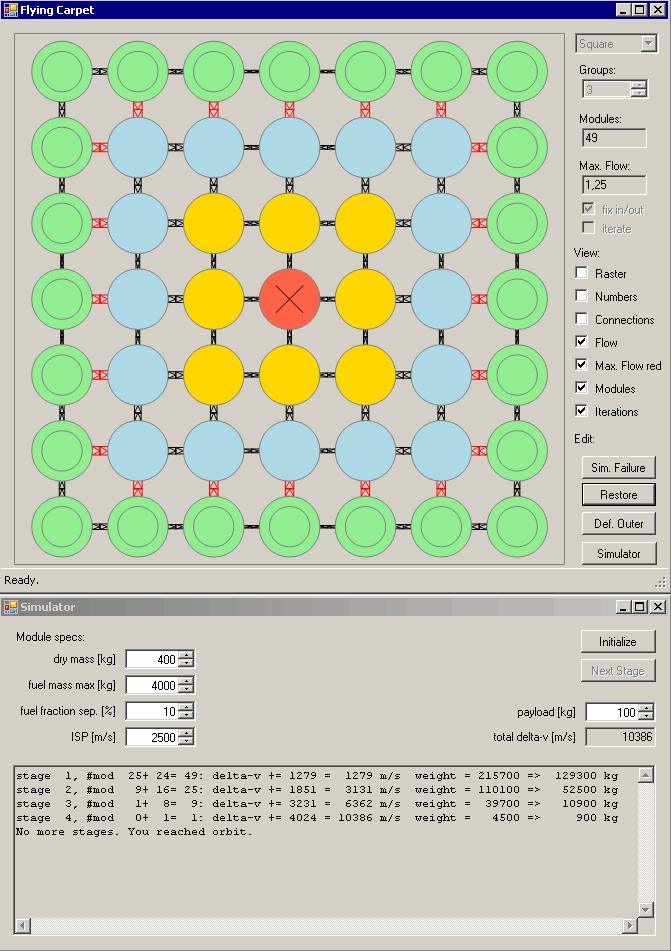
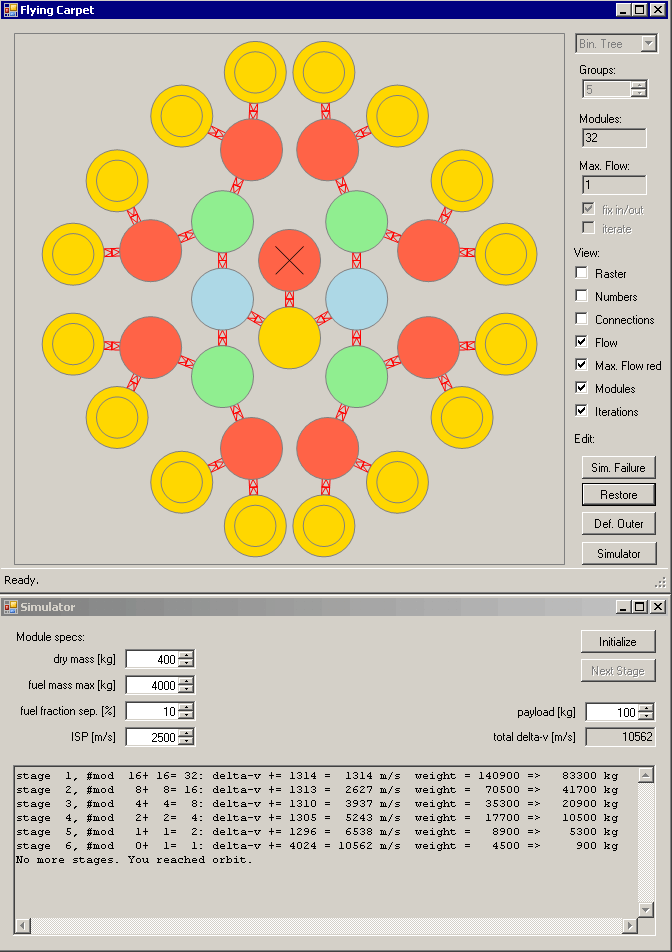
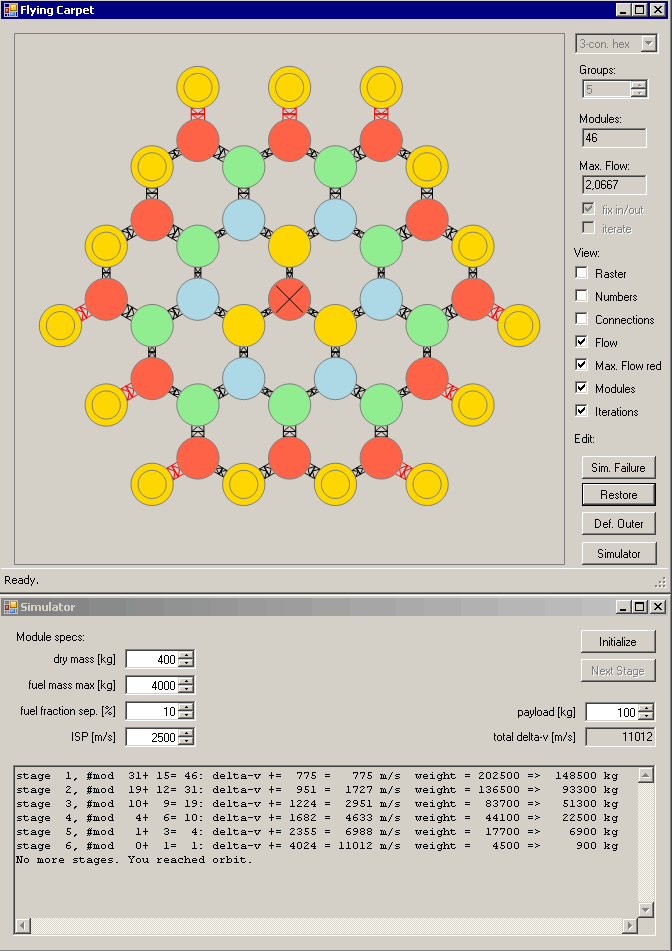

The numbers I used as module specification are a bit random. Probably the key to make this idea work is
to find out what is the largest and best performing module which can be built robust, reliable, and reusable
while still being economical. Then to find a way to exchange fuel and set up a swarm or network of them.
If you would like to play around with numbers of your own, here is the program: download c# executable v02.
If you prefer to compile the sources yourself, feel free to contact me by email.
Note: the central module carrying payload has a higher load to carry.
This could be compensated by starting with the central modules tanks partially empty.
Or by adding another rocket engine or a more powerful one. This is currently neglected in the simulation.
By the way, engineers during the Apollo aera were very clever. Why didn't they come up with this idea?
My guess is: because precision control of a rocket to that degree was beyond 1960s technology.
Landing a rocket on its tail was a "crazy idea" until DC-X flew. Now it seems to have moved from state of the art
to commonly available technology.
Another weekend, a minor idea: given that the flow over a connection is limited, the scaling can be stretched a little by choosing outer modules different. For example left you see the square carpet with 4 groups, while right the outer two groups are combined. Max flow gets down to the level of the carpet with 3 groups, but number of modules is like carpet with 4 groups. Simulation tool shows that final delta-v goes down a bit due to carrying along more dead weight for longer, but in the end it is not too much.
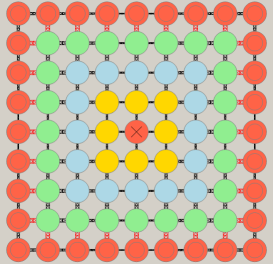
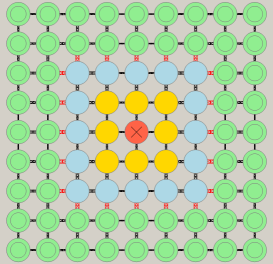
Another option to reduce maximal flow would be to allow inner modules to empty their tanks a bit. Again some delta-v is lost.
Rephrased the idea for an email discussion:
"My thesis is, having modules hover side by side, connected only by
flexible hoses reduces the complexity of coordinating a large number of
smaller rockets, at least from the mechanical point of view. Control
problems in the sense of control-loops become bigger, but can be handled
well with modern electronics.
Overall the additional degree of freedom in engineering choices may open
up a way to cheaper access to space.
Did you see a sea-launch mishap this year? I haven't found a detailed
analysis, but from what I gather from the internet a single problem in
the turbo pump destroyed all of the spacecraft in a chain reaction.
These large structures are vulnerable. Smaller modules are more stable
mechanically (given the same relative amount and quality of material is
used). The laws of physics and geometry say so. An elephant will hurt
itself fatally when falling down the height of his body. A human may
still hurt himself, but usually wont be crippled permanently and most
certainly wont die. A cat has no problem with falling down 10 times its
height (well, most cats still don't like it ;-) .
You are right saying the overall probability of an engine failure goes
up when using many engines. Many engine failures are "silent", e.g.
engine does not ignite or terminates early. With many engines, a single
one failing "silent" can be tolerated. This has already happened to
launch vehicles. With the idea proposed here, it is possible to
introduce redundancy in ways that even a violent failure of an engine
has good chances not to harm the vehicle. E.g. add some spare modules
and some spare connections to re-route fuel flow (see my simulation tool).
Have a look at
this video from Armadillo Aerospace for an
example. The engine bursts and the module falls down immediately. In case of the flying
carpet, it would have disconnected from the flying carpet very quickly.
Connections have to be designed to snap open in cases like this. Chances
of fragments damaging modules hovering a few meters aside seem to be
quite low. If they do, chances are still good the next module will fail
gracefully. No chain reaction here that destroys all of the vehicle.
If too many modules fail, the vehicle can abort ascend and land safely
in many (most?) scenarios. Most of the modules can be reused for the
next launch attempt."





